Here is an exclusive look at Cataclysm from the Big Board with detail explanations and play notes from Scott and William the designers. This is Part One of Two.
The P500 page also has four example videos with game play! The designers expect to post the full rule-book as it stands in the next few weeks so we can get a handle on how she plays first hand. Cataclysm has 111 orders to go to break the 500 barrier and is gaining attention in various circles. From the videos and this report it is an interesting mid weight title that takes a fresh look at the complexities of the European conflict and attempts to distill them down to their essence.
The guys have been kind enough to write this session play for us so lets see what the fuss is all about!
Example of Play: Crisis in the West scenario
Scott will play the Fascists, controlling Germany and Italy. Bill will play the Democracies, controlling France and the United Kingdom. The scenario takes place in Europe only, so Japan is not in the game. To limit the scope of this introductory scenario, the United States and Soviet Union are similarly out of play.
The scenario begins in 1937 with all four powers having already begun rearmament. Germany has reoccupied the Rhineland, and a civil war has broken out in Spain.
Let’s begin.
1937-38
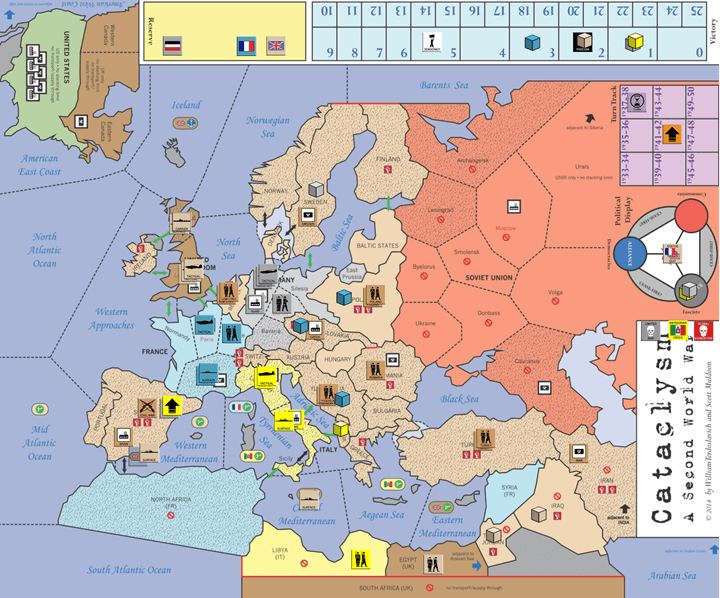
Production Phase
The Crisis in the West scenario, like all scenarios, begins with the production phase at the start of the turn. This gives each power a chance to set their course right from the start.
The production phase is conducted in increasing effectiveness order, so more effective powers can see what their less effective colleagues are up to.
First up is France. Although both France and Italy have an effectiveness of 1, Democracies lose effectiveness ties to Fascists and the French are considered “lower” than the Italians.
We’ll follow France’s production phase in detail, and then summarize for the other powers.
Most powers get a flag (political currency) as part of production. However, under Status Quo the Democracies do not automatically receive a flag – they may choose to gain one, but must make a stability check if they do. Bill declines a risky stability check for France and does not take a flag. France begins the game with a flag in reserve, and Bill decides to leave it there.
Next, France determines how many resources it collects. Each resource must trace a line of communications to a production site (i.e. a home industrial resource area) to be eligible for collection. The industrial resource in Paris is naturally available (no LOC necessary). The resource in Provence can trace to adjacent Paris and is also available. Even though France controls Czechoslovakia and Romania, Democracies cannot collect resources from outside home areas while under Status Quo.

 Bill takes two resource markers to represent the two French resources. He can flip them to their “offensive” side, or convert them into builds. France’s commitment is “rearmament” which means each resource is worth one build. Bill chooses to convert both resource to builds, giving him a total of two builds.
Bill takes two resource markers to represent the two French resources. He can flip them to their “offensive” side, or convert them into builds. France’s commitment is “rearmament” which means each resource is worth one build. Bill chooses to convert both resource to builds, giving him a total of two builds.
Bill looks over the French force pool – slim pickings. He decides to spend one build on an air force. With the other build and the French “refit” marker, he can construct a fleet for his one remaining build (fleets normally cost two). The fleet is placed on the turn track for next turn (in the 1939-40 space). Bill leaves the French flag in reserve.




 Italy‘s production phase is much simpler. First, it gains a flag – and since the special Il Duce flag is available, Scott chooses to gain that one.
Italy‘s production phase is much simpler. First, it gains a flag – and since the special Il Duce flag is available, Scott chooses to gain that one.
Italy has only one resource available, the industrial one in Lombardy. Since Italy’s commitment is at rearmament, the resource converts to one build. Scott chooses an army from Italy’s force pool. He puts the army in the action cup and the Il Duce flag in reserve.

The United Kingdom is next, with an effectiveness of 2 compared to Germany’s 3.
Like France, the UK labors under Status Quo which prevents them from receiving a free flag during production. Bill declines to make a stability check to gain a flag, since the UK has one in reserve already.

 Britain has access to two resources: the industrial one in London (which doubles as its production site) and the resource in Canada, which has no trouble tracing a line of communications overseas to London. Britain also controls resources in India and Australia on the Pacific theater half of the map, but being colonies those are out of play at the moment (due to Status Quo).
Britain has access to two resources: the industrial one in London (which doubles as its production site) and the resource in Canada, which has no trouble tracing a line of communications overseas to London. Britain also controls resources in India and Australia on the Pacific theater half of the map, but being colonies those are out of play at the moment (due to Status Quo).
Rather than flip them to their offensive sides, Bill converts them to builds, one each since the UK’s commitment is at rearmament. Bill selects one fleet from the UK force pool and places it on the turn track for next turn (fleets cost two builds and are delayed one turn). Bill leaves the British flag in reserve.


 Finally, Germany starts its production phase by gaining two flags (by special rule, Germany gains two instead of one during production). Combined with the flag in reserve at start, Germany has three flags for the turn so far.
Finally, Germany starts its production phase by gaining two flags (by special rule, Germany gains two instead of one during production). Combined with the flag in reserve at start, Germany has three flags for the turn so far.



 Germany has access to two industrial resources, in Ruhr and Berlin, but also can collect two limited resources from Ruhr and Sweden. Limited resources can only be collected once, then they are discarded out of the game. Scott decides not to wait for full mobilization and collects both limited resources now, giving Germany a total of four.
Germany has access to two industrial resources, in Ruhr and Berlin, but also can collect two limited resources from Ruhr and Sweden. Limited resources can only be collected once, then they are discarded out of the game. Scott decides not to wait for full mobilization and collects both limited resources now, giving Germany a total of four.
Scott converts all four of these resources to builds at the 1:1 rate allowed by Germany’s commitment level of rearmament. With four builds, Scott chooses a fleet and two submarine packs from Germany’s force pool. He places the fleet on the turn track in the 1939-40 box, one German flag in reserve, and the remaining two flags and two submarine packs in the action cup.



With production finished, we move on to the action phase for 1937-38.
Action Phase
As of now, every power has a flag in reserve. The reserve is used for game actions a player wants to take right away at the start of a turn, or to control the timing of a particular action during the turn rather than relying on the random draw from the action cup.
 Before drawing the first counter from the action cup, Germany announces it will trump with its flag from reserve.
Before drawing the first counter from the action cup, Germany announces it will trump with its flag from reserve.
No other power can trump before Germany, because Germany has the highest effectiveness.
 Germany plays its flag and chooses the propaganda political action, to attempt to increase its stability from “wavering” to “steady”. Every political action requires an effectiveness check to succeed: roll dice equal to the acting power’s effectiveness, and if the highest die is 5 or more the action is successful. Germany’s effectiveness is three, so Scott rolls three dice, scoring 6, 5, 4. Since the highest die is at least 5, the propaganda action is successful, and Germany’s stability rises to steady. Successful or not, Germany’s flag is returned to the available box on its power card.
Germany plays its flag and chooses the propaganda political action, to attempt to increase its stability from “wavering” to “steady”. Every political action requires an effectiveness check to succeed: roll dice equal to the acting power’s effectiveness, and if the highest die is 5 or more the action is successful. Germany’s effectiveness is three, so Scott rolls three dice, scoring 6, 5, 4. Since the highest die is at least 5, the propaganda action is successful, and Germany’s stability rises to steady. Successful or not, Germany’s flag is returned to the available box on its power card.
The United Kingdom declines its chance to trump using the flag it has in reserve.
Italy cannot trump here because the last counter played was German, also Fascist. A power can’t trump if the last played counter is associated with a power in its ideology.

 France chooses to trump next, spending its flag from reserve to attempt the ally political action, to form an alliance with the United Kingdom. An alliance allows greater political and military cooperation. Both parties must spend a flag to attempt an ally action, so the UK’s flag in reserve is spent as well.
France chooses to trump next, spending its flag from reserve to attempt the ally political action, to form an alliance with the United Kingdom. An alliance allows greater political and military cooperation. Both parties must spend a flag to attempt an ally action, so the UK’s flag in reserve is spent as well.
France’s effectiveness is lower than the UK’s (1 against 2), so France must make the effectiveness check by rolling one die. The roll is 3, short of the 5 or more needed for success. The French and British flags are returned to the available boxes on their respective power cards.
When a political action fails, the attempting power gets to place a cube in the failed actions box, which provides a bonus to the next political action attempt. However, diplomacy and ally actions never add a cube to the failed action box, nor do they benefit from the failed action bonus.
Italy declines to trump, so we draw the first counter of the turn from the action cup.
 The first counter drawn is the German
The first counter drawn is the German
home front marker. A home front marker forces the associated power to pass an effectiveness check or lose stability, reflecting the impact of national policy on domestic politics.
Germany will roll three dice (for its effectiveness of 3). Home front checks are penalized based on the power’s current commitment – Germany’s commitment level of rearmament comes at no penalty, however. Scott rolls three dice and gets 6, 4, 1– with a high die of 6, Germany passes the check and its stability remains unchanged.
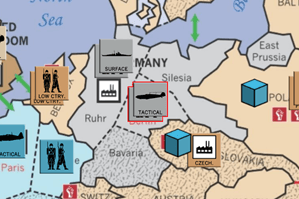 So far, the German people are behind Hitler’s aggressive military buildup.
So far, the German people are behind Hitler’s aggressive military buildup.
After making a home front check, whether successful or not, the associated power may make a free
deploy military action, allowing the power to shift its forces within friendly territory. Germany uses this opportunity to move its tactical air force from the Ruhr to Berlin.
Scott is anticipating action in Eastern Europe, and wants to be sure he has air superiority should it come to blows in Czechoslovakia.
Once again, Italy has the opportunity to trump but declines.
From this point, we will omit when powers decline to trump, to avoid redundancy.
 The next counter drawn from the cup is a crisis marker. Crisis markers introduce random events into the game, and also serve as a “clock” – the turn ends when all four crisis markers have been drawn.
The next counter drawn from the cup is a crisis marker. Crisis markers introduce random events into the game, and also serve as a “clock” – the turn ends when all four crisis markers have been drawn.
 Scott rolls two dice, reading the higher number first, and consults the crisis table for peacetime (since war between powers has not yet broken out). A roll of 4, 3 gives the result of Political Crisis: United Kingdom, which reduces the UK’s effectiveness by 1 for the remainder of the turn. The UK effectiveness marker is flipped to its -1 side and moved down to the 1 box on the effectiveness track.
Scott rolls two dice, reading the higher number first, and consults the crisis table for peacetime (since war between powers has not yet broken out). A roll of 4, 3 gives the result of Political Crisis: United Kingdom, which reduces the UK’s effectiveness by 1 for the remainder of the turn. The UK effectiveness marker is flipped to its -1 side and moved down to the 1 box on the effectiveness track.
The retirement of Stanley Baldwin and appointment of Neville Chamberlain to premiership does not go over well, it seems.
 Another counter is drawn; this time it is the French
Another counter is drawn; this time it is the French
home front marker. France must make an effectiveness check, rolling one die. Since France’s commitment level is rearmament, there is no penalty to the roll. Bill rolls one die and gets a 3, failing the check. France’s stability falls one level, from wavering to unstable.
Labor strikes rip through the French economy in response to rearmament! One more stability loss, and France will collapse!
 France declines to use its free deployment. Fortunately the very next chit drawn is a French air force. Units enter play at a production site, and then may deploy any distance for free. Bill constructs the air force in Paris, then moves it to Provence.
France declines to use its free deployment. Fortunately the very next chit drawn is a French air force. Units enter play at a production site, and then may deploy any distance for free. Bill constructs the air force in Paris, then moves it to Provence.
 The next counter is drawn from the action cup – a German flag. Germany decides the time is ripe for action, and spends the flag for an increase commitment political action. If successful, Germany’s commitment will rise from rearmament to mobilization, granting Germany increased production and military efficiency, as well as some “free” offensives.
The next counter is drawn from the action cup – a German flag. Germany decides the time is ripe for action, and spends the flag for an increase commitment political action. If successful, Germany’s commitment will rise from rearmament to mobilization, granting Germany increased production and military efficiency, as well as some “free” offensives.
Mobilization is required before one can start a war against other powers…
 Germany rolls three dice for the effectiveness check, and gets 6, 3, 2. The check is successful, and Germany mobilizes! Germany’s commitment marker is shifted from rearmament to mobilization, then flipped to its “increased” side as a reminder that Germany cannot increase commitment again this turn. As indicated on its power card, Germany’s force pool limit increases from 12 to 16, so Scott chooses four counters to add to Germany’s force pool: a fortress, a submarine pack, a surface fleet, and an air force upgrade marker.
Germany rolls three dice for the effectiveness check, and gets 6, 3, 2. The check is successful, and Germany mobilizes! Germany’s commitment marker is shifted from rearmament to mobilization, then flipped to its “increased” side as a reminder that Germany cannot increase commitment again this turn. As indicated on its power card, Germany’s force pool limit increases from 12 to 16, so Scott chooses four counters to add to Germany’s force pool: a fortress, a submarine pack, a surface fleet, and an air force upgrade marker.




This is a decidedly anti-British force mix, especially in light of Germany’s build choices during production.

 Germany also receives two “bonus” offensive markers for mobilizing, one for each industrial resource under German control and in communications: one in Ruhr and one in Berlin. Scott puts one offensive into reserve (handy!) and adds the other one to the action cup.
Germany also receives two “bonus” offensive markers for mobilizing, one for each industrial resource under German control and in communications: one in Ruhr and one in Berlin. Scott puts one offensive into reserve (handy!) and adds the other one to the action cup.
 Increasing commitment is a provocation against certain powers – in this case, Germany’s action provokes France, the United Kingdom, and the Soviet Union. France and the UK each gain a flag; Bill immediately places both in reserve. Provocation of the Soviet Union in this scenario results in Germany taking a Soviet cube, which may result in a loss of victory points at the end of the scenario (representing the level of enmity from the Russians).
Increasing commitment is a provocation against certain powers – in this case, Germany’s action provokes France, the United Kingdom, and the Soviet Union. France and the UK each gain a flag; Bill immediately places both in reserve. Provocation of the Soviet Union in this scenario results in Germany taking a Soviet cube, which may result in a loss of victory points at the end of the scenario (representing the level of enmity from the Russians).
Finally, Germany increasing commitment to mobilization triggers the end of Status Quo (see the Democracies special rules card). With Status Quo removed from play, the Democracies will have more political and economic freedom to respond to aggressive action. Also, since Status Quo was removed in response to a Fascist action, the Democracies immediately each gain a flag. Since France and the UK already have flags in reserve, the newly gained flags go directly into the action cup.

 Bill decides to respond immediately to the German threat, and declares that he will trump with the French flag in reserve. Again, France will attempt to ally with the UK – both their flags are spent, and France rolls one die. A 2 results in another failure.
Bill decides to respond immediately to the German threat, and declares that he will trump with the French flag in reserve. Again, France will attempt to ally with the UK – both their flags are spent, and France rolls one die. A 2 results in another failure.
Despite intensive talks at a high military level, France and Britain cannot agree on how to handle Hitler’s alarming rhetoric.
 Democratic inaction prompts the Fascists to strike while the iron is hot. Germany now trumps to play its offensive from reserve. When an offensive is played, it grants up to three military actions, depending on the power’s commitment level. With Germany at mobilization, the offensive is worth two military actions.
Democratic inaction prompts the Fascists to strike while the iron is hot. Germany now trumps to play its offensive from reserve. When an offensive is played, it grants up to three military actions, depending on the power’s commitment level. With Germany at mobilization, the offensive is worth two military actions.
Germany declares its first military action will be a campaign. As a Fascist power, Germany is free to attack any unoccupied country without constraint. Scott chooses to activate the army in Berlin to attack Czechoslovakia. This is a provocation against France, who has a cube marking control there, and France gains a flag. Bill places the French flag in reserve.
Note that invading Czechoslovakia is not an act of war against France – the Czechs are allies, but not occupied by French forces. Further, the French cannot interfere since they are not at war with Germany. The Czechs must defend on their own.
Scott moves the German army from Berlin to Czechoslovakia. Air forces in or adjacent to the combat area may support the campaign. Scott declares the German tactical air force in Berlin will support and also moves it into Czechoslovakia.
Next, air superiority is determined – with no air units to oppose them, the Germans win air superiority automatically.
To resolve the land combat, each side must determine how many dice to roll and what bonuses and penalties apply. The Germans start with two dice since they have an army. They roll an additional die due to air superiority. The Czechs roll only one die since they have no army. However, they get a +1 bonus on the roll for the adverse terrain (rough pattern) in their country.
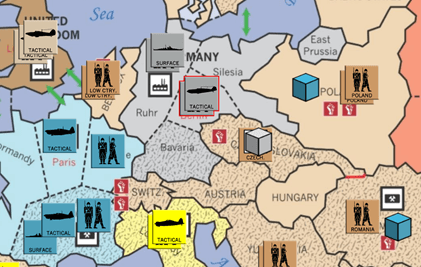 The Germans roll 6, 3, 1 for a final score of 6. Bill rolls for the Czechs, scoring a 3, which is increased to a final score of 4. The Germans defeat the Czechs 6 to 4. Dividing the Czech result of 4 into the German 6, dropping fractions, we determine the Czechs must suffer one loss. Since the Czechs have no army to lose, the loss is ignored.
The Germans roll 6, 3, 1 for a final score of 6. Bill rolls for the Czechs, scoring a 3, which is increased to a final score of 4. The Germans defeat the Czechs 6 to 4. Dividing the Czech result of 4 into the German 6, dropping fractions, we determine the Czechs must suffer one loss. Since the Czechs have no army to lose, the loss is ignored.
Since the only army remaining in the battle area is German, Germany takes control of Czechoslovakia and Scott replaces the French cube with a German one. Germany (and Fascism) gain one victory point, and France (and Democracy) loses one victory point.
Germany may now regroup, moving units among the combat area and adjacent friendly areas, but Scott chooses to leave the army and air force in Czechoslovakia for the moment.
Germany decides to spend its second military action to deploy. The German army and air force in Czechoslovakia are back moved through Berlin to the Ruhr.
Having secured an easily accessible resource in Czechoslovakia, Germany prepares for its next move against the complacent West.
 Concerned about the precarious French position, Bill trumps with the French flag in reserve to attempt a propaganda action. France rolls one die and scores a 4, which fails. Bill adds a French cube to the failed action box. France will get a +1 bonus on its next political action (except for a diplomacy or ally action).
Concerned about the precarious French position, Bill trumps with the French flag in reserve to attempt a propaganda action. France rolls one die and scores a 4, which fails. Bill adds a French cube to the failed action box. France will get a +1 bonus on its next political action (except for a diplomacy or ally action).
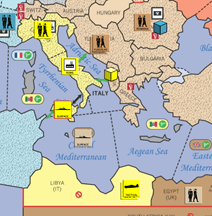
 Next, the second crisis marker is drawn from the action cup. Two dice are rolled with a result of 4, 1 – Political Crisis: Soviet Union. In another scenario, this would reduce Soviet effectiveness by one for the remainder of the turn, but with no Soviet player this result is ignored.
Next, the second crisis marker is drawn from the action cup. Two dice are rolled with a result of 4, 1 – Political Crisis: Soviet Union. In another scenario, this would reduce Soviet effectiveness by one for the remainder of the turn, but with no Soviet player this result is ignored.
 The next counter is drawn – Italian
The next counter is drawn – Italian
home front. Italian effectiveness is only 1, and Scott rolls one die. A result of 5 passes the check, and Italy’s stability remains at steady. For its free deploy action, Italy moves its air force from Lombardy to Libya using naval movement through the Adriatic and Aegean Seas. Italy also moves its fleet from Rome to Sicily via the Tyrrhenian Sea.
This signals hostile intent against British possessions in the Mediterranean.

 The next counter drawn from the cup is the third crisis marker. With only one crisis marker left in the cup, the turn can end at any moment. As a reminder, the turn marker is flipped to its sudden death side.
The next counter drawn from the cup is the third crisis marker. With only one crisis marker left in the cup, the turn can end at any moment. As a reminder, the turn marker is flipped to its sudden death side.
Two dice are rolled on the peacetime crisis table – 1, 1 indicates Cataclysm! Two crises for the price of one!
 A further roll on the table results in 3, 2: Abyssinian Crisis. Italy takes the Abyssinian Crisis marker and must spend a military action before the end of the turn, or be forced to make a stability check.
A further roll on the table results in 3, 2: Abyssinian Crisis. Italy takes the Abyssinian Crisis marker and must spend a military action before the end of the turn, or be forced to make a stability check.
The second crisis table roll is 6, 5: Low Countries Declare Neutrality. With no control cubes in Benelux, the crisis event has no effect.
 With the end of the turn possible at any time, Italy finally decides to trump with its flag in reserve, playing it for an increase commitment action to go from rearmament to mobilization. Normally Italy’s effectiveness of one allows rolling only a single die for effectiveness checks; however, the flag played is the special Il Duce flag, and Italy may roll an additional die for this action only (a total of two). The roll of 3, 1 results in failure, and Scott places an Italian cube in the failed political action box.
With the end of the turn possible at any time, Italy finally decides to trump with its flag in reserve, playing it for an increase commitment action to go from rearmament to mobilization. Normally Italy’s effectiveness of one allows rolling only a single die for effectiveness checks; however, the flag played is the special Il Duce flag, and Italy may roll an additional die for this action only (a total of two). The roll of 3, 1 results in failure, and Scott places an Italian cube in the failed political action box.
Mussolini apparently cannot convince his generals to follow the dangerously aggressive path Hitler is on.
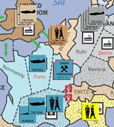

 Next out of the cup is a French fortress. Bill must place the unit in a French production site, and only Paris qualifies. The fortress is placed in Paris on its “under construction” side. Bill uses the free deploy to move the fortress to the adjacent Lorraine area, the historical location of the Maginot Line.
Next out of the cup is a French fortress. Bill must place the unit in a French production site, and only Paris qualifies. The fortress is placed in Paris on its “under construction” side. Bill uses the free deploy to move the fortress to the adjacent Lorraine area, the historical location of the Maginot Line.
Fortresses fight like armies, but cannot attack or retreat. While operational, they provide a +1 bonus when defending. During any future deploy action, an under-construction fortress can be flipped to its operational side instead of moving.
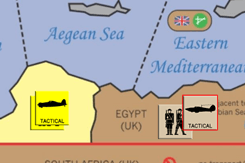
 A new counter is drawn from the cup – a German submarine pack. Scott places the subs in Ruhr, but moves them to Silesia (leaving stacking room for the new German fleet due next turn).
A new counter is drawn from the cup – a German submarine pack. Scott places the subs in Ruhr, but moves them to Silesia (leaving stacking room for the new German fleet due next turn).
 The next counter drawn is the British home front marker. Bill rolls only one die, since British effectiveness has been reduced to one by the political crisis earlier in the turn. The roll is 3, and public opinion in Great Britain shifts against the war party. The UK’s stability slips from steady to wavering. Britain uses the free home front deploy action to ship an air force from London through the Mediterranean Sea to Egypt.
The next counter drawn is the British home front marker. Bill rolls only one die, since British effectiveness has been reduced to one by the political crisis earlier in the turn. The roll is 3, and public opinion in Great Britain shifts against the war party. The UK’s stability slips from steady to wavering. Britain uses the free home front deploy action to ship an air force from London through the Mediterranean Sea to Egypt.
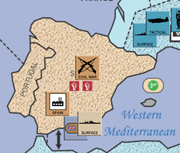
 Going back to the cup, the Civil War Resolution marker is drawn. So far the only civil war on the map is the one in Spain from the initial setup. Germany and Italy have aid markers in place supporting the Right faction (i.e. Franco’s Nationalists). The Left (Republicans) has no aid markers (a Soviet aid marker was lost during the 1935-36 historical turn, before this scenario starts).
Going back to the cup, the Civil War Resolution marker is drawn. So far the only civil war on the map is the one in Spain from the initial setup. Germany and Italy have aid markers in place supporting the Right faction (i.e. Franco’s Nationalists). The Left (Republicans) has no aid markers (a Soviet aid marker was lost during the 1935-36 historical turn, before this scenario starts).
To resolve the civil war, each side rolls two dice, but the side with more aid markers gets to roll an extra die. The Right has more aid, so the Fascists roll three dice, getting 5, 2, 1. The Democracies roll two dice for the left and get 6, 2. The Left wins 6 to 5, and the German and Italian aid markers are removed, returning to their respective available boxes. However, the Republican victory is not decisive and the civil war continues.
If the Right had no aid to start with, the Left’s victory would have ended the war, albeit with no lasting effects on the great power struggle unfolding around them.
 Finally, the fourth crisis marker is drawn from the cup, and the turn ends. Note that no crisis event is rolled for the last crisis marker drawn.
Finally, the fourth crisis marker is drawn from the cup, and the turn ends. Note that no crisis event is rolled for the last crisis marker drawn.
End Phase
With the turn over, the remaining contents of the action cup and turned out: two British flags, one German flag, one German offensive, one German submarine pack, one Italian army, and one Italian fleet.







These will be handled momentarily, but first…
Italy still has the Abyssinian Crisis marker it received during an earlier crisis. Since it did not spend a military action to discard it, Scott must make a stability test for Italy. Rolling one die for Italy’s effectiveness of one (Il Duce cannot help here), he gets a 3 and Italy’s stability falls to wavering.
Next, we look for home front markers – they were all drawn during the turn, so no home front checks are required at this time.
Now, any units remaining from the cup are placed at appropriate production sites: Scott places the German sub in the Ruhr, and the Italian army and fleet in Lombardy.
Note that none of these units are allowed to deploy since they were placed during the End Phase.
Finally, the British flags, German flag, and German offensive are placed in the 1939-40 box on the turn track, to be added to next turn’s production.
These excess counters will be held by the producing power until the end of the production phase and disposed of in accordance with the normal rules for production (think of them as leftover income).
 With that, the turn is officially complete, and the turn marker is flipped back to its front side and advanced into the 1939-40 box. All the pieces there (mostly crisis and home front markers) are added to the action cup immediately in preparation for the new turn.
With that, the turn is officially complete, and the turn marker is flipped back to its front side and advanced into the 1939-40 box. All the pieces there (mostly crisis and home front markers) are added to the action cup immediately in preparation for the new turn.
Part Two coming soon.

one I’ve been waiting for. Hoped I could avoid T&T and Churchill (yeah, good luck there) – but this looked like the pick of the crop to me.